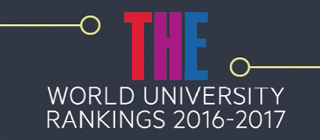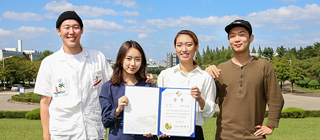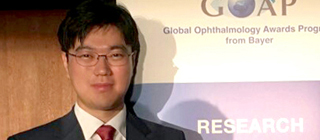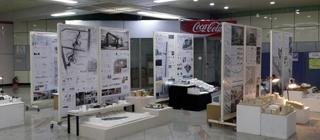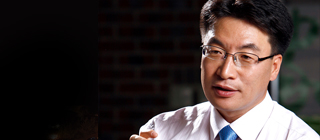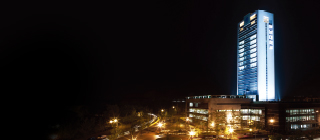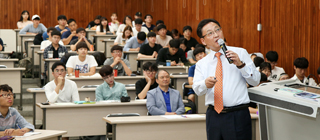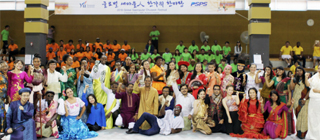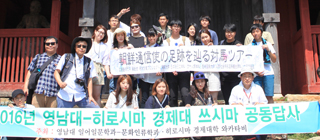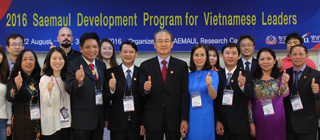-
Top world college evaluations in the world together with QS Ranked 890 universities from 79 countries around the world, including 25 Korean universities such as YU High evaluations in world college rankings such as the QS Asian University Rankings and Leiden Ranking [September 23, 2016] YU (President Noh Seok-kyun) was ranked 16th (601-800 in the world) in the '2016-2017 World College Rankings' by the British college ranking institute, 'THE' (Times Higher Education). On the 22nd, THE announced the world college rankings that include 890 colleges in 79 countries. A total of 25 Korean universities were listed including YU, Seoul National University (72nd), KAIST (89th), and Pohang University of Science and Technology (104th). In particular, YU was ranked at a tied 16th for Korean universities together with Kyungpook National University, Kunkook University, Ajou University, Inha University, Chonbuk National University, and Chonnam National University. Ranked first overall in this evaluation was Oxford University of England, while Caltech, Standford University, Cambridge University, and the Massachusetts Institute of Technology (MIT) were ranked 2nd to fifth. THE, which was founded in 1971, is a prominent global college ranking institute together with the British QS (Qaucquarelli Symonds), and it announced world college rankings annually since 2004. THE's world college rankings apply strict standards based on classes, research, influence and internationalization, and it is assessed worldwide to have high public confidence. Meanwhile, YU was ranked 128th (22nd in Korea) among Asian universities in the '2016 Asia College Rankings' announced by QS in June. While most of the major universities in Korea dropped in ranking, YU climbed 22 ranks from 150th in 2013 to 128th this year. Earlier in May in the '2016 Leiden Ranking', which ranks colleges around the world based on the qualitative level of theses, YU was ranked 50th in the world and first in Korea in the mathematics and computer science sector, thus being recognized for its world-class research capacities. YU President Noh Seok-kyun said, "This is an objective evaluation of our school's status by world acclaimed college ranking institutes." He added, "I hope that not only YU, but the universities of Korea compete fairly with prestigious schools around the world to enhance their education and research levels to global standards."
-
10 awards in the world's top 3 design contests Learned various subspecialties such as products, environment and transportation tht helped in the graduation piece production curriculum [September 26, 2016] <Department of Industrial Design students awarded at design contests> (left to right: Lee Shi-bin, Cha Young-ah, Lee Jin-hee, Kim chan-seop) Students of the YU Department of Industrial design are making a name for themselves by winning awards at various contests both in Korea and abroad. These students took home a total of 10 awards such as the Gold Prize at the '2016 Spark Design Awards' of the US, grand prize, participation award and select awards at the '2016 Pohang Steel Design Contest', gold prize and select award at the '2016 Busan Public Design Contest', and the silver prize at the '2016 Gumi Public Design Contest'. Among them, Miss Lee Ji-hye (22, junior), who was awarded the gold prize at the '2016 Spark Design Awards', had three of her works named as award winners in the global contest by having two more of her works also selected as 'finalists'. At the '2016 Pohang Steel Design Contest' that recently announced the winning works, 127 works from both undergraduate and graduate students competed. Students from the YU Department of Industrial Design took first place with their works. The winners were the same-age friends from the class of '12 Kim Chan-seop (24) and Lee Shi-bin (24). Their piece wa titled 'Haeddi‘, which is a table clock that doubles as a mood light. Lee Shi-bin said, "We got our motif from the solar eclipse that appears in the story of Yeonorang and Saeonyeo. The clock needle hidden inside creates a shadow with the internal light and that needle shadow indicates the time," while adding, "Even clocks don't have to show the time all the time, so we designed it to also double over as a mood light, which I think received good responses." Earlier at the '2016 Busan Public Design Contest', Lee Jin-hee (20, sophomore) and Cha Young-ah won the gold prize for their work titled 'Protecting the Sky'. 'Protecting the Sky' is a piece that designed a variable handrail that could be used on stairways or hilly neighborhoods when people go up and down. Lee Jin-hee said, "We wanted to give some leisure to life for people who walk up and down steep and dark paths by providing them with a place of rest and convenience facilities." She added, "We designed the rails that could adjust the width and length so that people could lean on it and rest. In addition, we added a light under the rails to providing lighting and to improve the nighttime ambience of alleys." The winners all agree that the reason why the works of students from the YU Department of Industrial Design stood out at various contests was because of their curriculum. The winners said, "Among the various fields of industrial design such as products, environment and transportation, we are required to designate a major and minor and learn at least two subspecialties and produce actual works for the graduation exhibit," and added, "This curriculum helped us to see objects and the environment from various perspectives for our designs."
-
First Korean to win the award by proposing excellent research that can lead to the development of the field of ophthalmology Active research such as publishing in global SCI journals in the basic medicine and clinical fields "I will do research to develop cures for diabetic retinopathy and macular degeneration that can lead to blindness" [September 20, 2016] YU College of Medicine Professor of Ophthalmology Lee Joon-yeop became the first Korean to win the 'Global Ophthalmology Awards Program, Research Award'. The 'Global Ophthalmology Awards Program, Research Award' was created for the development of research in the global ophthalmology sector by the global pharmaceutical company 'Bayer'. Bayer is famous for 'aspirin', a household drug found in almost all homes around the world for relieving fevers and as a painkiller. The 'Global Ophthalmology Awards Program, Research Award' is given to researchers who proposed studies expected to have significant impact on the development of the future ophthalmology sector. The Grant Review and Awards Committee comprised of 13 scholars in ophthalmology and basic medicine selects winners through strict reviews over two phases to support around 100 researchers a year, and then awards 3 to 5 winners. This is the first time for a Korean researcher to win the 'Global Ophthalmology Awards Program, Research Award'. Professor Lee won this award with his research titled, 'Choroidopathy related to perictye as pathologies of macular degeneration and diabetic maculardema' and will receive 50,000 dollars in research funding. Professor Lee remarked, "It is a great honor to win the 'Global Ophthalmology Awards Program, Research Award' for the first time as a Korea," and added, "My goal is to develop treatment to cure diabetic retinopathy and macular degeneration that can lead to blindness." Professor Lee graduated from the YU Medical School and after earning his license as an ophthalmologist, he earned his PhD by carrying out basic research at the KAIST Graduate School of Medicine. After working at the Seoul Asan Medical Center, he began serving as a professor at YU from March of this year. In addition to diagnosis and operations, he also has a lab for carrying out basic research on blood vessels. Professor Lee has been highly active in the two fields of basic medicine and clinical sectors by publishing recent research results in global SCI journals such as Science Translational Medicine, which is a world-acclaimed journal in the medical sector, and 'Ophthalmology', the world's most authoritative journal on ophthalmology. Meanwhile, Professor Lee received this award at the 16th European Society of Retina Specialists conference held on the 8th in Copenhagen, Denmark.
-
30 students majoring in architectural engineering newly design 16 specialty streets in Jung-gu Exhibit held in the subway at Banweoldang Station, captivating commuters Following the Daemyeong Concert Culture Street designs last year, becoming established as a tradition for graduation exhibits [September 20, 2016] <Students majoring in architectural design in the School of Architecture held their graduation exhibition at Banweoldang Station of subway line 1> Works that newly designed the Specialty Street of Daegu were put on display at a subway station to attract the attention of commuters. Students majoring in architecture design at the YU School of Architecture (Dean Koo Bon-deok) held their graduation exhibit at Banweoldang Station of Daegu Metrol Line 1. About 30 students majoring in design preparing to graduate in February of next year designed famous streets in Jung-gu, Daegu with brilliant ideas to recreate the streets. They proposed remodeling major buildings and plans to improve street environments for 16 specialty streets in Jung-gu such as the Bongsan Culture Street and Dongseong-ro, as well as the 'Plans to Promote Ddeokjeon Alley', 'Jin Alley where Time Flows Slowly' and 'Bongsan Furniture Street that Applies Furniture Linking Methods in the Streets' based on the theme of 'Promoting Specialty Streets'. Jung-gu Office (Director Yoon Soon-young) thought highly of the proposals by the students and provided various support to hold exhibits such as providing exhibition spaces at Banweoldang Station in the heart of Daegu. It is receiving a lot of interest amount subway commuters as a rare architecture design exhibit is offered here. In particular, the works that designed alleys using various models are especially popular. YU School of Architecture Professor Kim So-hee said, "By combining the practical academic discipline of architectural design to public places that many people use, students making their pieces were able to concentrate better, and people showed more interest as well." She added, "The brilliant ideas of students majoring in architecture design will improve the living convenience of the people, and also contribute in breathing energy into the city." The YU School of Architecture put on display works regarding the Daemyeong Concert Culture Street in Nam-gu, Daegu at Myeongdeok Station on subway line 3 last year, and newly designed the streets of Jung-gu this year, receiving great praises from the community. The YU School of Architecture major in architecture design was established in 2008 to foster future-oriented environmental engineers who can comprehensively design internal and external areas of buildings. Rather than the traditional graduation exhibit focusing on individual works, students preparing for graduation analyze a specific region in Daegu and are making attempts in architectural design works that can contribute to urban activation by connecting it with their majors. Meanwhile, this exhibit, which is being held at the waiting room entrance in B3 of Banweoldang Stations Daegu Metro Line 1, will be held until the 30th.
-
Thomson Reuters announced 3,200 researchers with the most cited theses in the world 105 people in the math sector listed In past 5 years, published over 100 SCI academic journal papers, cited 7,446 times [September 9, 2016] Department of Electrical Engineering Professor Park Ju-hyun (48) was selected as the world's top 1% researcher for the second consecutive year. Thomson Reuters recently announced 3,200 'Highly Cited Researchers' in the world. Professor Park was listed for the second consecutive year in the math sector. There were a total of 105 scholars named in the math sector, and Professor Park was selected as one of the most influential researchers of the world. Thomson Reuters is a global academic information service company and operates the biggest academic information database called 'Web of Science' of the world. Thomson Reuters utilizes the Web of Science Database and examines the number of citations of papers published by researchers around the world to select the Highly Cited Researchers in the top 1% every year. The number of citations is the most common scale for grading the qualitative level of a thesis. Being listed in the 'Highly Cited Researchers' is equivalent to being recognized for world-class research capacities. This year, a total of 128,887 papers that had the highest number of citations among papers in 21 fields such as science and social science published from 2004 to 2014 were analyzed to announce a total of 3,200 researchers in the top 1%. Professor Park published over 100 papers as the principal author for the past five years. The number of citations of his works is currently 7,446. Furthermore, the 'H-Index', which is a major index for evaluating the qualitative level of a paper, was found to be 48. Having a number of 48 for the H-index means that there are 48 theses with more than 48 citations. This means that he has published many papers with high qualitative levels. The qualitative excellence of Professor Park's studies was once again confirmed to be of the world best in SCOPUS and Google Scholar, which are other academic databases. Google Scholar recognized the excellence of the research by having a total of 12,118 citations and H-Index of 59, while SCOPUS stated 9.148 citations and an H-Index of 52. Professor Park explained, "I normally deal with basic research related to controller design for stabilization and analyzing the safety of various linear and non-linear kinetic systems such as time delay systems, kinetic network, chaos system, intelligence system, and multiple object systems." He added, "I am planning to further integrate the results of the basic studies in application research such as system biology, cyber physics system, and smart drones, and I will continue international joint research with prominent researchers around the world. Professor Park earned his PhD in electric and electronic engineering at Pohang University of Science and Technology and began serving as a professor at YU since March 2000. He is currently active as an editor for a number of prominent international academic journals such as the 'IET Control Theory and Applications' published by the Institution of Engineering and Technology and 'Nonlinear Dynamics' published by Springer, which is a global publisher for the science, technology and pharmaceutical sectors. He served as an expert at the National Research Foundation Basic Research Center for four years from 2012, and he is also leading the 'Next Generation Smart Mechatronics System Development' team, which is being pursued as part of the Ministry of Education's 'BK21 Plus' project. In 2013, he was awarded the 'Knowledge Creation Award' by the Ministry of Science, ICT and Future Planning.
-
-
YU President holds regular lecture on 'Convergence Humanities' Lecture titled ‘Features of Modern Society and Role of Universities’, discussion with students “Courage and will power that does not fear failure will lead to success” [September 13, 2016] <YU President Noh Seok-kyun takes the podium as the first speaker for the 2016 second semester regular course, 'Convergence Humanities'> YU President Noh Seok-kyun took the podium for the first time after taking office as the university president for a lecture on a regular course. At 3 p.m. on the 6th, at Room 210 of the Commerce and Economics Hall, President Noh took the stage as the first speaker for 'Convergence Humanities', a regular general education course for the second semester of 2016. Mr. Noh spoke for 90 minutes under the topic, 'Features of Modern Society and Role of Universities'. All 300 students who filled the classroom to listen to Mr. Noh's lecture, who took the podium after a long time, listened carefully to each and every word. Mr. Noh said, "Communication is essential to resolve the various social conflicts of modern society, and a perspective of humanities is needed for this." He added while emphasizing the importance of humanities saying, "I am placing close attention to humanities lectures such as the 'Humanity at 20 Years Old' that was newly established last year and 'Convergence Humanities'. We will further expand general education lectures so that students will gain more wisdom for life through the humanities." At this lecture, Mr. Noh also displayed his abilities as an engineering student. Students responded well to his easy-to-understand explanations for scientific knowledge on the Big Bang theory and the features of molecules. Mr. Noh, who was rarely able to have opportunities for direct communication with students on the college issues, also took the time for dialog with students through this lecture. Mr. Noh carefully explained in detail the recent major achievements and policies of the university that directly affect students such as the government's college financial support projects and student-oriented academic programs. He also introduced the history and spirit of YU and alumni in various parts of society to help students understand the identity of the university and to enhance their school pride. As the lecture went on to the university's history, current issues and policies that are usually not talked about in regular lectures, students showed more attention than ever. Students who attended the lecture said, "I did not know how our school was evaluated in college evaluations, how we won so many national funding projects, and I also did not know that there were so many alumni doing great things in society. It was an opportunity to look back at our school and gain pride in our school." They added, "I hope that the university and the president of the university will communicate with students using various methods so that more students can go to school with a sense of pride and love for their school." Mr. Noh responded to this saying, "We will continuously communicate through the YU newsletter, college homepage and SNS. If need be, I will meet with students directly and speak with them." President Noh stated, "I know that this is a period of uncertainties and concerns. The difficulties that the youths face now are obstacles that must be overcome, but it is also a driving force for success." He added, "There is no scheduled success and there is no accidental failure. Courage and strong will power that does not fear failure is the key to success," as he ended his lecture. Meanwhile, YU has been receiving good responses from students since opening the 'Humanities at 20 Years Old' and 'Convergence Humanities, which are general education classes in humanities since last year. These humanities lectures that were prepared with the goal of having students ask themselves on more creative and hopeful paths, rather than spending their youths lost in thought and worries, are held as weekly marathon lectures by speakers related to humanities in various fields.
-
Park Chung Hee School of Policy and Saemaul holds 'Global Saemaul People's Chuseok Festival' Joined by over 270 people including international students from 50 countries and professors Experiencing Korean culture through traditional folk games such as jaegi-chagi, samul-nori, and yut-nori [September 9, 2016] <Over 240 international students from 50 countries participated in the '2016 Global Saemaul People's Chuseok Festival'> International students enrolled at YU (President Noh Seok-kyun) spent a very special Chuseok this year. The Park Chung Hee School of Policy and Saemaul held the '2016 Global Saemaul People's Chuseok Festival' for international students studying in a far-away country. This is the fourth year that the '2016 Global Saemaul People's Chuseok Festival' was held since first starting in 2013. On the 9th, six days prior to the nation's largest holiday Chuseok, this event was held at the Gyeongsan Indoor Gymnasium and was held in its largest-ever scale with 241 international students from 50 countries studying at the Park Chung Hee School of Policy and Saemaul, with an addition of staff and faculty for a total of 270 people. Director Park Seung-woo, who prepared for this event, said in his greetings, "Chuseok is Korea's biggest holiday to remember the importance of family by meeting and talking with family, and sharing food." He added, "I hope that you can once again think about the importance of family and friends back home this Chuseok. I hope that through this festival today, you will experience traditional Korean culture and make many fun memories." Khalid Farooq (33, 3rd term in master's degree course in Saemaul and International Development) from Pakistan, who participated in this event, said, "In addition to the academic fields such as Saemaul and international development, I want to experience as much as I can about Korean culture as well while studying here," and added, "It is great to have the opportunity to experience Korea's traditional culture and hang out with friends from school at this event. The traditional fashion show of various countries displayed by my classmates was especially interesting." This event kicked off with international students from countries around the world showing off their traditional clothes in a fashion show. It was followed by traditional games such as jaeg-chagi and yut-nori, while international students also participated in samul-nori performances and talent shows in a fun and exciting time for understanding Korean culture. Ngwira Msimuko Priscilla (40, second term in master's degree course for public policy and leadership) from Zambia who participated in the fashion show said, "I know the meaning of Chuseok that is spent with family," and added, "Though I am far away from my family in Zambia, I spent a great time wearing traditional clothes and putting on a show with my friends from around the world who I met while studying at the Park Chung Hee School of Policy and Saemaul. This will be a moment that I will never forget while studying in Korea."
-
YU and Hiroshima University of Economics engage in joint exploration projects in Korea and Japan Following the traces of the Joseon Tongshinsa and also examine the modern history and culture of Daegu Invited to the 'Joseon Tongshinsa Event' hosted by the Korean Consulate General in Hiroshima and make joint presentation of the visitation results Plans to sum up the exploration route and propose tourist packages to Japan's largest travel agency [August 29, 2016] <YU-Hiroshima University of Economics regional join exploration project team visits Tsushima Banshoin, Japan's nationally designated historic site> Joint projects pursued by college students of Korea and Japan are receiving attention as a new type of Korea-Japan cultural exchange. This is the 'Joint Exploration Project in Korea and Japan' conducted by the YU Department of Japanese Language & Literature and the Hiroshima University of Economics. This project was pursued after the Hiroshima University of Economics 'Wakatabi project team' proposed the 'Joint exploration of Tsushima (Daema-do), Japan' under the theme of Joseon Tongshinsa in February of this year. The Wakatabi project team is one of the 17 student-led project teams pursued by the Hiroshima University of Economics and it is a project team that explores areas both in and outside of Japan under the theme of traveling, and it proposes new travel plans. As part of the joint exploration, the two universities held a meeting to examine the past, present and future of Korea-Japan exchange from the 8th to 14th. In a three night and four day schedule from the 8th to 11th, students from the two universities chased the tracks of the Joseon Tongshinsa in Tsushima, Japan. The students listened to the lectures and commentaries of local researchers of Tsushima and Joseon Tongshinsa experts, and engaged in local exploration activities focusing on the regions related to Korea-Japan exchanges. In addition to YU Department of Japanese Language & Literature and Hiroshima University of Economics students, professors and graduate students of the YU Department of Cultural Anthropology archaeology exploration team and the Nagasaki International University also participated and received warm responses from the students of the two countries. <Results of the joint exploration are being presented at 'Daegu-Haru', a Korea-Japan cultural exchange space located in Daegu> The students who completed their activities returned to Korea on the 11th and held an opportunity to organize the results of the joint exploration and to share what they learned at YU until the 14th. They presented their joint exploration activities in Japan at 'Daegu-Haru', which is a space for cultural exchange between Korea and Japan in Jung-gu of Daegu, and shared their opinions (photo on left). Furthermore, they visited the Daegu Modern History Museum and the Heeum Japanese Military Comfort Women History Museum and the Daegu Chinese School to share their thoughts about the history and culture of Daegu in modern history, as well as the history of Korea and Japan. Lee Min-hee (24) a senior at the YU Department of Japanese Language & Literature who participated in the Korea-Japan joint exploration activities, said, "In order to trace the tracks of our ancestors and Korea remaining in Japan, we conducted thorough preliminary investigations for three weeks before carrying out the on-site investigations." She added, "It was fulfilling because we were able to see and feel many different things. It was also great that the exploration was conducted with senior students majoring in cultural anthropology who shared a lot of their expertise." This joint exploration project will go beyond being simply exchange activities between universities, but be used in a variety of ways in connection with government institutes and companies. Five students from the YU Department of Japanese Language & Literature were invited to the regular Joseon Tongshinsa event held jointly by Hiroshima Prefecture and the Korean Consulate General scheduled for October. At this event, YU students will present the joint exploration results together with students from the Hiroshima University of Economics, and are also scheduled to participate in the Joseon Tongshinsa parade. Furthermore, in February of next year, the contents of the joint exploration will be summed up and proposed as a travel package to Japan's largest travel agency, JTB, and is expected to assist in the cultural exchange with other citizens. <Visit to Daegu Chinese School> YU Department of Japanese Language & Literature Dean Choi Bum-soon said, "We are planning to actively pursue exchange under the theme of regional understanding and peace activities between Korea and Japan based on sister schools such as the Hiroshima University of Economics and Hiroshima University." He added, "By spreading the cultural exchange activities that started with college students into different fields, it will contribute in expanding the mutual understanding of Korea and Japan, which has complex historic, political and social relations. Meanwhile, YU made sisterhood relations with the Hiroshima University of Economics in February of 2011 and has been pursuing exchange projects. In October of last year, the YU Department of Japanese Language & Literature and the Japanese culture visiting team (24 people) visited the Hiroshima University of Economics and engaged in cultural exchange activities under the theme of Korea-Japan peace to begin full-fledged exchange between the two universities.
-
YU Saemaul Research Center invites public officials from Dinh Hoa District of Thai Nguyen Province of Vietnam for Saemaul training MOU signed between Cheongdo-gun and Dinh Hoa District to pursue Saemaul project village in Dinh Hoa [August 29, 2016] YU has been receiving good responses from emerging nations by operating Saemaul development training programs to spread the Saemaul Undong in rural areas of emerging countries that have exchange and cooperation relations with Korean provincial organizations. The YU Saemaul Research Center (Director Choi Wae-chul), together with Cheongdo-gun, held the 'Saemaul Development Project for Vietnamese Leaders' from the 22nd to the 29th. This training program scheduled for eight nights and nine days was joined by 10 people including public officials from Dinh Hoa District of Thai Nguyen Province of Vietnam. They received training on understanding the Korean Saemaul Undong and sharing its experiences, the Saemaul spirit and Saemaul education, how to exercise the Saemaul Undong, roles of leaders and resident participation, and on the agricultural industry and cooperatives of Korea. They then discussed plans to apply the Saemaul Undong suitable to Vietnam. They also visited the place where the idea for the Saemaul Undong was formulated and participated in on-site learning. Dinh Hoa District of Thai Nguyen Province in Vietnam is where the Saemaul pilot village project supported by Cheongdo-gun since 2014 is being carried out. In 2014, Cheongdo-gun and Dinh Hoa District signed an MOU to improve mutual friendships and to pursue a project to establish the Saemaul pilot village. Since then, they have been engaged in various exchange projects such as annual visits and dispatching Saemaul leader volunteers. This training program was held at the request of Cheongdo-gun to YU, which is an institute specializing in Saemaul Undong education, in order to expand and develop the Saemaul project in Dinh Hoa District. YU Saemaul Research Center Director Choi Wae-chul who oversaw the training program said, "The success of the Saemaul Undong is highly influenced by reforming the mindsets of residents based on proper understanding of the Saemaul spirit and the philosophy of leaders such as the intent to continue to pursue policies." He added, "I hope that this training program will be an opportunity to examine Korea's experiences and cases and act as a good guideline for applying the Saemaul Undong to fit the circumstances of Vietnam." The representative of the training team and Vice Mayor of Ding Hoa District Pham Viet Dung (right on photo) said, "Through this training session, I was able to see the unprecedented development of Korea and the role of the Saemaul Undong in detail," while adding, "I am thankful to YU and Cheongdo-gun for this opportunity, and I would like to invite Director Choi Wae-chul to Dinh Hoa, Vietnam so that more public employees in Vietnam can learn about Saemaul." Meanwhile, YU signed the 'MOU for the establishment and operation of the Saemaul Research Center to promote the Saemaul spirit of Cheongdo, which is where the idea for the Saemaul Undong was formulated' in 2010 with Cheongdo-gun and has been operating programs for Saemaul education and exercising the Saemaul spirit for different social classes from children to adults, Saemaul leaders, teachers, and foreigners.
